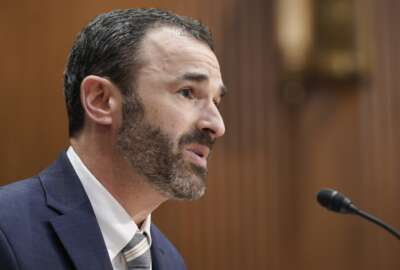HHS thinking creatively to implement new Pathways flexibilities
After a major Pathways Program update, HHS is already looking at how to implement the new flexibilities into its program, while working with resources at hand.
After a governmentwide update to the Pathways Program, the Department of Health and Human Services is already looking at how to start implementing the new flexibilities into its program.
But many of those flexibilities, which the Office of Personnel Management finalized in April, are optional, rather than required. That means it depends on an agency’s resources to make them a reality, and in many cases, requires agencies to think creatively.
“It really is being strategic in how we do outreach for recruitment to make sure that we are maximizing our resources,” Kimberly Steide, associate deputy assistant secretary for human capital at HHS, said in an interview with Federal News Network. “The interest is there, the passion is there, it’s really just finding the time and the resources to do as much as we want to do … and thinking about where we can get the most impact for the resources that we have available.”
Higher starting salaries, for instance, are now a possibility for employees that agencies hire through Pathways. Under OPM’s new regulations, agencies can offer a starting salary up to a GS-11 rate, rather than being capped at GS-9 rates as they were previously. Though offering a higher starting salary isn’t a requirement, Steide said she expects HHS will use the flexibility as much as possible.
“Salary is a big draw for many people early in their career,” Steide said. “A lot of that will be driven by budget, of course, but at the end of the day, we have a huge interest in ensuring that we have a solid pipeline of talent. And we have to start that with early-career talent.”
Governmentwide, the Pathways Program lets early-career employees take a temporary position at an agency, with the potential to later convert into a full-time position in the career civil service. OPM’s final regulations changed many different aspects of Pathways, intending to open the doors to more diverse applicants and alleviate the challenges agencies have historically had with the program.
For HHS, like many agencies, the program is central to early-career recruitment overall.
“Early-career talent is really important, and we’ve been strategically trying to do much more to engage and advance recruitment using many of these flexibilities,” HHS Chief Human Capital Officer Bob Leavitt said in an interview. “We have to be extraordinarily creative and innovative in how we share practices across the department to help us all move forward collectively. There’s so much that the human capital side is responsible for across the board. And one way of being efficient with those resources is really building up those communities of stakeholders, communities of practice.”
OPM’s recent updates to Pathways also reduced the requirements to complete the program, offered part-time options, and made candidates who have completed career or technical education programs, in place of a college degree, eligible for the program.
“I think that flexibility will be attractive for a lot of people,” Steide said.
HHS has used Pathways for over a decade, which is as long as the program has been around. Departmentwide, HHS hires roughly 600 employees annually through Pathways in a combination of the three programs: recent graduates, interns and Presidential Management Fellows. HHS’ main human capital office works with each agency subcomponent to determine their staffing projections and help them monitor the program.
“Many of our subcomponents are very well-branded and known. Some are not as well-known,” Steide said. “So it’s just ensuring that when people interact with HHS, they understand everything that we have to offer in terms of all of the different missions, and how they can build a really successful career with HHS.”
Leavitt and Steide said it’s also important to make sure Pathways is a good experience for anyone involved — starting from the recruitment aspect, but also extending to the entire time employees are involved in the program at HHS.
“We really try to bring them in in a cohort style, where we provide programming for them,” Steide said. “We try to have activities where we bring them together, so that they have a sense of community.”
But keeping Pathways participants within the agency full time isn’t always the end goal. In some cases, OPM’s final regulations now let Pathways employees, when converting to a full-time position, move to a different agency than the one with which they completed the program.
OPM added that flexibility, in part, because Pathways participants nearing the end of the program may not always find a full-time opening at their agency that’s a good fit. In those cases, the agency can then place that employee on OPM’s applicant talent portal. The online platform lets other agencies review available candidates and, if they’re a good fit and the employee is interested, hire them.
“That gives them some sense of security, in the sense of being able to be converted anywhere across government, as opposed to the agency that picked them up,” Steide said. “I think one of the best things that OPM did was to develop this portal because it demonstrates for the government that while we might not be able to place you where you were originally picked up, we do want to retain you.”
In general, Leavitt and Steide said OPM’s support of early-career hiring is “palpable.” OPM also has a governmentwide community of practice specifically focused on early-career talent recruitment.
“We have significant support through those communities of practice, through the technical tools that OPM helps provide us all,” Leavitt said. “There are a lot of opportunities to collaborate — collaborate with OPM, across government and within the departments to advance these areas.”
“I personally have seen a lot of synergy with OPM in the sense of trying to help governmentwide, bring resources together and strategically look at ways to approach recruitment and how best to reach early-career talent,” Steide added. “And it goes further than just recruiting them. It is really about [what] you provide them once they come on board.”
Copyright © 2025 Federal News Network. All rights reserved. This website is not intended for users located within the European Economic Area.
Drew Friedman is a workforce, pay and benefits reporter for Federal News Network.
Follow @dfriedmanWFED






